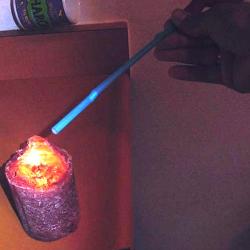Source Institutions
Add to list Go to activity
Activity link broken? See if it's at the internet archive

In this demonstration, learners compare and contrast regular water ice to dry ice (frozen carbon dioxide). Both samples are placed in a solution of acid-base indicator. The regular ice floats and the acid-base indicator does not change color; the dry ice sinks and the acid-base indicator changes color to show an acid solution has formed. This demonstration is part of a set of demonstrations and activities that can be used together for a larger lesson. Resource contains vocabulary definitions and suggestions for assessment, extensions, and scaling for different levels of learners.
- Under 5 minutes
- 5 to 10 minutes
- $1 - $5 per group of students
- Ages 8 - 14
- Activity, Demonstration
- English
Quick Guide
Materials List (per group of students)
- 2 medium-size beakers, each half full of bromothymol blue (BTB) solution (solution = 6 drops per 1/3 cup water)
- 1-2 small pieces of ice (cubes)
- 1-2 small pieces of dry ice
- Hot Stuff! Activity 1 Worksheets
Subjects
-
Earth and Space Science
-
Earth Processes
- Weather and Climate
-
Earth Structure
- Atmosphere
-
Earth Processes
-
Engineering and Technology
-
Engineering
- Civil Engineering
- Environmental Engineering
-
Engineering
-
Life Sciences
-
Ecology
- Human Impact
-
Ecology
-
Physical Sciences
-
Chemistry
- Acids and Bases
- Solutions
-
States of Matter
- Changes of Phase
-
Chemistry
Audience
To use this activity, learners need to:
- see
- see color
Other
Includes alignment to state and/or national standards:
This resource is part of:
Access Rights:
- Free access
By:
- Kolenbrander, Amy ; Yowell, Janet ; Mach, Natalie ; Schaefer Zarske, Malinda ; Carlson, Denise ; Kotys-Schwartz, Daria
Source Collection
- TeachEngineering
Rights:
- All rights reserved, Regents of the University of Colorado, 2004
Funding Sources:
- Fund for the Improvement of Postsecondary Education (FIPSE)
- U.S. Department of Education
- National Science Foundation, 0226322
